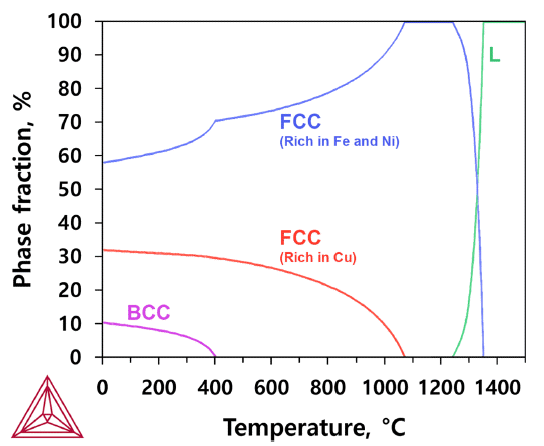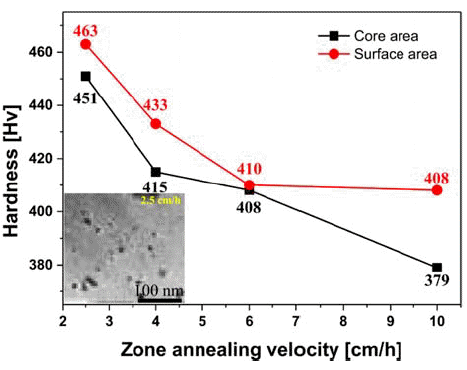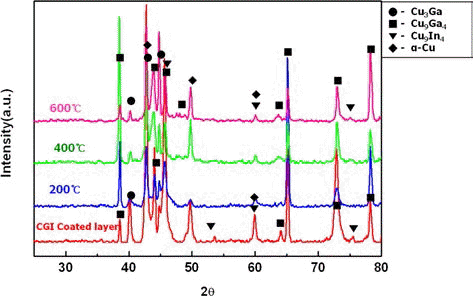Search
- Page Path
- HOME > Search
- [English]
- Fabrication of FeCuNi alloy by mechanical alloying followed by consolidation using high-pressure torsion
- Peyman Asghari-Rad, Yongju Kim, Nhung Thi-Cam Nguyen, Hyoung Seop Kim
- J Korean Powder Metall Inst. 2020;27(1):1-7. Published online February 1, 2020
- DOI: https://doi.org/10.4150/KPMI.2020.27.1.1

- 1,155 View
- 4 Download
- 2 Citations
-
 Abstract
Abstract
 PDF
PDF In this research, a new medium-entropy alloy with an equiatomic composition of FeCuNi was designed using a phase diagram (CALPHAD) technique. The FeCuNi MEA was produced from pure iron, copper, and nickel powders through mechanical alloying. The alloy powders were consolidated via a high-pressure torsion process to obtain a rigid bulk specimen. Subsequently, annealing treatment at different conditions was conducted on the four turn HPT-processed specimen. The microstructural analysis indicates that an ultrafine-grained microstructure is achieved after post-HPT annealing, and microstructural evolutions at various stages of processing were consistent with the thermodynamic calculations. The results indicate that the post-HPT-annealed microstructure consists of a dual-phase structure with two FCC phases: one rich in Cu and the other rich in Fe and Ni. The kernel average misorientation value decreases with the increase in the annealing time and temperature, indicating the recovery of HPT-induced dislocations.
-
Citations
Citations to this article as recorded by- High-pressure torsion of face-centered cubic multi-principal element alloys: Nanostructuring and its influence on properties
Avanish Kumar Chandan, Kaushal Kishore, Megumi Kawasaki, Terence G. Langdon, Jenő Gubicza
Progress in Materials Science.2025; : 101620. CrossRef - Effects of nickel content and annealing temperature on the magnetic characteristics of nanostructured FeCu alloys
Abderrahmane Younes
Journal of Materials Science: Materials in Electronics.2024;[Epub] CrossRef
- High-pressure torsion of face-centered cubic multi-principal element alloys: Nanostructuring and its influence on properties
- [Korean]
- Effect of Zone Annealing Velocity on the directional Recrystallization in a Ni base Oxide Dispersion Strengthened Alloys
- Young-Kyun Kim, Seong-June Yoon, Jong-Kwan Park, Hwi-Jun Kim, Man-Sik Kong, Kee-Ahn Lee
- J Korean Powder Metall Inst. 2018;25(4):331-335. Published online August 1, 2018
- DOI: https://doi.org/10.4150/KPMI.2018.25.4.331

- 534 View
- 2 Download
- 1 Citations
-
 Abstract
Abstract
 PDF
PDF This study investigates the directional recrystallization behavior of Ni based oxide dispersion strengthened (ODS) alloy according to the zone annealing velocity. The zone annealing temperature is set as 1390°C, while the zone velocities are set as 2.5, 4, 6, and 10 cm/h, respectively. The initial microstructure observation of the as-extruded sample shows equiaxed grains of random orientation, with an average grain size of 530 nm. On the other hand, the zone annealed samples show a large deviation in grain size depending on the zone velocities. In particular, grains with a size of several millimeters are observed at 2.5-cm/h zone velocity. It is also found that the preferred orientation varies with the zone annealing velocity. On the basis of these results, this study discusses the role of zone velocities in the directional recrystallization of Ni base ODS alloy.
-
Citations
Citations to this article as recorded by- Directional recrystallisation processing: a review
Chao Yang, Ian Baker
International Materials Reviews.2021; 66(4): 256. CrossRef
- Directional recrystallisation processing: a review
- [Korean]
- Fabrication and Microstructure/Properties of Bulk-type Tantalum Material by a Kinetic Spray Process
- Ji-Hye Lee, Ji-Won Kim, Kee-Ahn Lee
- J Korean Powder Metall Inst. 2016;23(1):8-14. Published online February 1, 2016
- DOI: https://doi.org/10.4150/KPMI.2016.23.1.8

- 605 View
- 2 Download
- 3 Citations
-
 Abstract
Abstract
 PDF
PDF A bulk-type Ta material is fabricated using the kinetic spray process and its microstructure and physical properties are investigated. Ta powder with an angular size in the range 9-37 μm (purity 99.95%) is sprayed on a Cu plate to form a coating layer. As a result, ~7 mm-sized bulk-type high-density material capable of being used as a sputter material is fabricated. In order to assess the physical properties of the thick coating layer at different locations, the coating material is observed at three different locations (surface, center, and interface). Furthermore, a vacuum heat treatment is applied to the coating material to reduce the variation of physical properties at different locations of the coating material and improve the density. OM, Vickers hardness test, SEM, XRD, and EBSD are implemented for analyzing the microstructure and physical properties. The fabricated Ta coating material produces porosity of 0.11~0.12%, hardness of 311~327 Hv, and minor variations at different locations. In addition, a decrease in the porosity and hardness is observed at different locations upon heat treatment.
-
Citations
Citations to this article as recorded by- Sintering Behavior and Microstructures of Tantalum and Tantalum-Tungsten Alloys Powders
Youngmoo Kim, Sung Ho Yang, Seong Lee, Sung Ho Lee, Joon-Woong Noh
Journal of Korean Powder Metallurgy Institute.2020; 27(5): 373. CrossRef - Manufacturing of Large-Scale Cold-Sprayed Ta Target Material and Its Sputtering Property
Gi-Su Ham, Dong-Yeol Wi, Jun-Mo Yang, Kee-Ahn Lee
Journal of Thermal Spray Technology.2019; 28(8): 1974. CrossRef - Mechanical properties of Mo-Nb-Si-B quaternary alloy fabricated by powder metallurgical method
Jong Min Byun, Su-Ryong Bang, Se Hoon Kim, Won June Choi, Young Do Kim
International Journal of Refractory Metals and Hard Materials.2017; 65: 14. CrossRef
- Sintering Behavior and Microstructures of Tantalum and Tantalum-Tungsten Alloys Powders
- [Korean]
- Influence of Oxidation Temperatures on the Structure and the Microstructure of GaN MOCVD Scraps
- Hyun Seon Hong, Joong Woo Ahn
- J Korean Powder Metall Inst. 2015;22(4):278-282. Published online August 1, 2015
- DOI: https://doi.org/10.4150/KPMI.2015.22.4.278

- 846 View
- 3 Download
- 1 Citations
-
 Abstract
Abstract
 PDF
PDF The GaN-powder scrap generated in the manufacturing process of LED contains significant amounts of gallium. This waste can be an important resource for gallium through recycling of scraps. In the present study, the influence of annealing temperatures on the structural properties of GaN powder was investigated when the waste was recycled through the mechanochemical oxidation process. The annealing temperature varied from 200°C to 1100°C and the changes in crystal structure and microstructure were studied. The annealed powder was characterized using various analytical tools such as TGA, XRD, SEM, and XRF. The results indicate that GaN structure was fully changed to Ga2O3 structure when annealed above 900°C for 2 h. And, as the annealing temperature increased, crystallinity and particle size were enhanced. The increase in particle size of gallium oxide was possibly promoted by powder-sintering which merged particles to larger than 50 nm.
-
Citations
Citations to this article as recorded by- High-temperature thermo-mechanical behavior of functionally graded materials produced by plasma sprayed coating: Experimental and modeling results
Kang Hyun Choi, Hyun-Su Kim, Chang Hyun Park, Gon-Ho Kim, Kyoung Ho Baik, Sung Ho Lee, Taehyung Kim, Hyoung Seop Kim
Metals and Materials International.2016; 22(5): 817. CrossRef
- High-temperature thermo-mechanical behavior of functionally graded materials produced by plasma sprayed coating: Experimental and modeling results
- [Korean]
- Manufacturing and Properties of CGI-based Composite Coating Layer Utilizing a Warm Spray Process and Cu-Ga and Cu-In Mixed Powders
- Min-Gwang Jeon, Myeong-Ju Lee, Hyeong-Jun Kim, Kee-Ahn Lee
- J Korean Powder Metall Inst. 2014;21(3):229-234. Published online June 1, 2014
- DOI: https://doi.org/10.4150/KPMI.2014.21.3.229

- 638 View
- 0 Download
- 2 Citations
-
 Abstract
Abstract
 PDF
PDF This study manufactured a CIG-based composite coating layer utilizing a new warm spray process, and a mixed powder of Cu-20at.%Ga and Cu-20at.%In. In order to obtain the mixed powder with desired composition, the Cu-20at.%Ga and Cu-20at.%In powders were mixed with a 7:1 ratio. The mixed powder had an average particle size of 35.4 μm. Through the utilization of a warm spray process, a CIG-based composite coating layer of 180 μm thickness could be manufactured on a pure Al matrix. To analyze the microstructure and phase, the warm sprayed coating layer underwent XRD, SEM/EDS and EMPA analyses. In addition, to improve the physical properties of the coating layer, an annealing heat treatment was conducted at temperatures of 200°C, 400°C and 600°C for 1 hour each. The microstructure analysis identified α-Cu, Cu4In and Cu3Ga phases in the early mixed powder, while Cu4In disappeared, and additional Cu9In4 and Cu9Ga4 phases were identified in the warm sprayed coating layer. Porosity after annealing heat treatment reduced from 0.75% (warm sprayed coating layer) to 0.6% (after 600°C/1 hr. heat treatment), and hardness reduced from 288 Hv to 190 Hv. No significant phase changes were found after annealing heat treatment.
-
Citations
Citations to this article as recorded by- Fabrication and Microstructure/Properties of Bulk-typeTantalum Material by a Kinetic Spray Process
Ji-Hye Lee, Ji-Won Kim, Kee-Ahn Lee
Journal of Korean Powder Metallurgy Institute.2016; 23(1): 8. CrossRef - Effect of Heat Treatment Environment on the Microstructure and Properties of Kinetic Sprayed Tantalum Coating Layer
Ji-Hye Lee, Hyung-Jun Kim, Kee-Ahn Lee
Journal of Korean Powder Metallurgy Institute.2015; 22(1): 32. CrossRef
- Fabrication and Microstructure/Properties of Bulk-typeTantalum Material by a Kinetic Spray Process
TOP
 KPMI
KPMI


 First
First Prev
Prev


